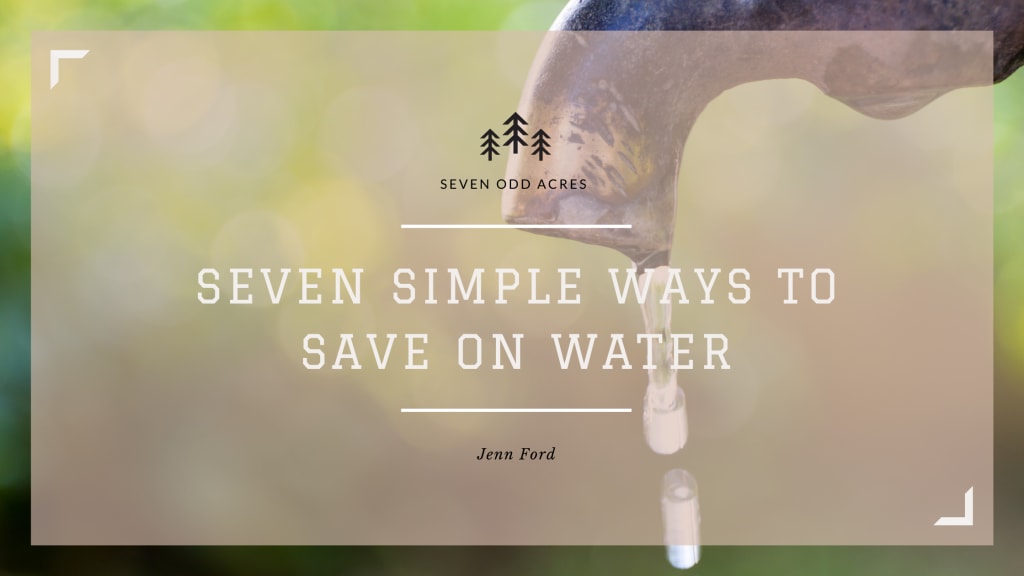
Before transitioning from town living to a little homestead I used to think that we were pretty water conscious. We did the things that you see and hear of, all the time, as water conservation tips. But, it wasn’t until being placed in a position where I had to haul our water that I really began to understand the hard truth -- most of our efforts to reduce water use were barely scratching the surface.
Things like high-efficiency appliances and toilets, making sure leaks are repaired and avoided, doing full laundry and dishwasher loads only and not running the taps. Those are obvious, right?
Now, you would think that not running the taps is an obvious one. But really, out of every five opportunities to turn off a tap instead of letting it run during a task, we were maybe doing one. So, while hauling load after load from the water-fill station to our homestead I eventually figured out how to take ‘not letting taps run’ and a few other water-saving techniques to a new level. Well, a new level for a North American. Because let's be honest here, most of the world already has this figured out. We are kind of the slow kids down the street when it comes to pretty much any kind of conservation.
Okay, back to the taps. This should be an easy one. Right? But it really isn’t for most people. We run the tap when brushing our teeth, waiting for warm or hot water, rinsing dishes, shaving our legs (if that’s your thing), and working in the kitchen. These are strong habits that are really tough to shift. We need water to do these things. Well, at least to do them comfortably. Still, there are a few simple things that we can do with taps to cut back our water use drastically while putting it to more beneficial use. And it is a nice easy place to start transitioning into better water-saving habits.
Taps
Use it-don't dump it: This habit probably came to me the easiest. Instead of tossing those half glasses of water that end up all over the place we dump them directly into plants or into a watering can, which I now have in each bathroom. The room temperature water is better for the plants than cold water too. So double win!
Collect Running Water: (Again, this is one for the watering cans.) Who wants to wash their face with cold water? Not me. Or if your hands are really icky, like from doing some serious farm-chorin’, you really need warm water to get them clean. I keep a mason jar and a large watering can in each bathroom. When we need to run the water until it is warm or hot we collect it in a jar to be dumped in the water cans. Now, this seems like it really wouldn’t make that much of a difference right? But it does. I was so surprised and impressed at how much water we collected when we first made this a habit. My watering cans are six litres. On a day when everyone is home and in and out of bathrooms, we can often nearly fill a watering can in our main bathroom. And that isn’t counting the water we run from the shower to get hot. We have a bucket in our main bathroom that we collect the water in while warming up the shower to take to fill up the chicken water or dog’s water.
We also use a Berkey filter for our drinking water. When we need hot water in the kitchen we collect the pre-warm water, again in a jar (I clearly can’t get enough of the jars) then dump that water into the top of the filter to use for drinking water.
This habit shift really doesn’t take much extra time or effort. You would run the tap for that time anyway, to get the warm water. It just adds a few extra seconds to dump into a watering can.
Stop and Soap: I am pretty sure that I am the only one in my family who does this. But I am hoping that it rubs off on the rest of the crew soon. I collect my pre-warm shower water then set the temperature. Wash my hair then face then turn the shower off to get soaped up and shave my legs. I have a cup that I fill to rinse my razor and then turn the shower back on to rinse and I’m done. I can get clean and get out with two minutes of running water. I think this habit is more valuable to me because I am the one watching our cistern like a hawk for when I have to spend a good half a day refilling it.
I’d like to get one of the showerheads that allows you to either turn the shower to low-flow or right off. That would make this one even simpler.
Shower Song
Time your showers: This can be made kind of fun and I have a bit more buy-in from the family here over my stop-and-soap routine. We each have a few shower songs, that are around the five-minute mark, we put them into playlists on our phones or just ask google to play for us when we start our showers. This gives us a window of time that doesn’t feel like it is ticking away. Get in, enjoy your song, get clean and get the hell out before mom threatens to make you do the water haul next week. (I can threaten all I want but the kids can’t reach the gas pedals yet and the water truck doesn’t like my husband, so, yeah.)
Greywater Harvest
Greywater can be simple: You can get some pretty amazing systems to divert, refilter and reuse your greywater for flushing toilets or irrigation. And we definitely want to do that when we build. But, for now, we are installing a switch in our drainage from our main bathroom shower and our washing machine. This will be able to be switched on in our warmer seasons to divert greywater to our raised garden beds. Now, this means that I need to up my game on using hippy-friendly laundry soap, but I have a few that I really like now. It also means that all of the water that would have been sent to the septic tank from our showers and laundry can now just go straight to watering the garden, which is another time-saver for me.
Rainwater
Collect Rainwater: A lot of people have some sort of rain catch set up for their homes and even on their garages. But, you can take this a step up or two as well. We set up our pig and chicken barns to collect the rainwater and divert it directly into their auto waters. I think this whole system could be an article of its own that I should do next.
But that's not all for rainwater. We haven’t tried this next tip yet but, we have some farmy-friends who collect their rainwater and divert it for their washing machine. They save massive amounts of water in the Summer. Clothes washing machines and toilets are the biggest consumers for water in most homes. This little trick took some creative engineering on their part but it has made a huge difference for them.
Mulch
Mulch Your Garden: Again, this could be a whole separate article but to sum it up, gardens need a lot of water. A lot of that water is lost in evaporation. But, if you put a good few inches of mulch over your beds and in your pots you can retain a lot of that otherwise lost water, thus using less overall. Mulching has added benefits when it brings nutrients as the water that is collected soaks through and carries to your soil and plants.
Plant Food Not Lawns
Grow Your Own: Take a look at your yards, both front and back. Is there any space that you just don’t really use other than to mow, week after week? Put in raised garden beds, then mulch those beds and collect your rainwater or greywater to water them.
There are some really simple ways to create water conscious grow spaces that can not only help you cut back on water use but cut back on your grocery bills with amazing fresh home-grown food for you and your family. I’ll have more on this topic in the coming weeks.
And if a planting area isn’t your thing or feasible, what else can you put down instead of lawn? A rock feature? Fireplace patio? The main point here is don’t water a lawn just for the sake of having a lawn. If that space can be put to more productive use, well, start planning that project and get cracking.
Composting Toilet
So many ways to group your poop: This was not my favourite experience on the homestead. Was it necessary for a time? Yes. Did it get us through a hard six months? Yes. Would I do it again if I could avoid it? There would have to be a really, very damn good reason for me to do it again. Still, this was our biggest water saver ever.
We didn’t just try composting toilets to be cool, though. This is a whole separate blog post to come. For now, I’ll give you the quick version. Our whole water system went down, right at freeze up. Water into the house for the first two months was not happening. So flushing the toilets required water hauled into the house, pail by pail. But then our septic tank had a major fail. We managed to get the septic tank going again but only just at minimal capacity and by diverting the wastewater directly under the house. Like free flow. Not in the pipes. We didn’t really want to run the poop like that. So, we did the composting toilet thing.
This was a serious water saver. Still not my favourite. Although, it wasn’t as gross to deal with as I originally thought that it would be. If you ever find yourself in a spot where you need or want to try a composting toilet, know that it can be done, it can be simple and it is not as gross as I thought it would be. The compost pile from that time has since turned to soil that was pushed flat with the tractor and now has very happy grass and weeds growing on it that our oldest daughter thinks is hilarious to call the poop-grass.
Wrap Up
These are just some of the things that we found most useful during our time building our little homestead and some while we were in town. I think tap collecting is a great easy place to start.
A good way to find out how you are doing with water conservation is to watch your water meter if you have one. Take a look at your water bill from the previous months and watch your meter as you shift into some of the habits above. You can also mark your water meter when you are not using any water then check back in a few hours to see if it has changed. If it hasn’t then great. If it does change while you are not using water then there may be a leak hiding somewhere. Fixing that will help reduce your water use too.
We don’t have a water meter so I just have to watch the level on our tank to see how we are faring in our water ways. But it works for us. Let’s see what works for you and what else you can discover to be more water conscious.
About the Creator
Jenn Ford
Mother of two making her way homesteading with her husband in the Northern boreal. Entrepreneurs who promote establishing several income streams. While working towards living more sustainably & sharing knowledge & lessons along the way.






Comments
There are no comments for this story
Be the first to respond and start the conversation.